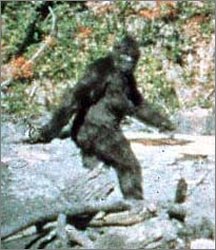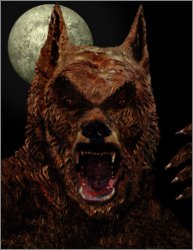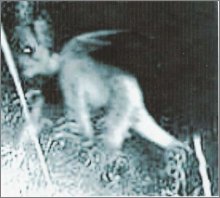Werewolves to Bigfoot and Beyond:
Which Monsters are Most Likely to Exist?
by www.SixWise.com
Some monsters, like the ones under your bed, really are all
in your head. Others, like the infamous Loch Ness Monster
and Bigfoot, seem to have one foot firmly planted in reality,
at least according to those who have seen them.
Just in time for Halloween, we delved into the murky histories
surrounding some of the world's most notorious monsters, all
to find out which ones may actually exist.
 1.
Bigfoot
1.
Bigfoot
There are thought to be roughly 2,000 to 6,000 Bigfoots in
North America, according to the Bigfoot Field Researchers
Organization (BFRO). Bigfoot, also called a Sasquatch, is
thought to be a large, hairy, human-like primate that lives
primarily in forested areas.
Reportedly, even President Teddy Roosevelt described a "sasquatch-like
animal" in his 1890 book, The Wilderness Hunter, that
stalked two trappers in an area that's now Wyoming or Montana.
BFRO maintains the only collection of Bigfoot reports from
across North America that has been investigated by researchers
to determine credibility. There are hundreds
of verifiable Bigfoot sightings listed on the site.
The famous photo of Bigfoot at right was filmed by Roger
Patterson in 1967 in Northwest California. The film has yet
to be discredited.
 2.
Loch Ness Monster
2.
Loch Ness Monster
Since 1933, countless people claim to have witnessed a long,
humped serpent-like creature swimming in Loch Ness, Scotland,
and even walking around on the nearby land.
Some have speculated that the Loch Ness Monster, also known
as Nessie, could be an ancient swimming reptile called a plesiosaur.
Though no hard evidence exists, there is plenty of anecdotal
evidence and some strange research findings. For instance:
-
In 1987, expedition "Operation Deep Scan" used
20 sonar-equipped boats to send a curtain of sound through
the loch. It found "three underwater targets that
could not be explained."
-
In the early 1990s, Nicholas Witchell of the BBC organized
Project Urquhart, a study that examined the biology and
geology of the loch. During the project, sonar operators
picked up a "large, moving underwater target and
followed it for several minutes before losing it."
-
In 1999, NOVA broadcast "The Beast of Loch Ness,"
which documented a three-week expedition into the loch,
using state-of-the-art sonar and sensitive underwater
cameras to track down the Loch Ness Monster. During the
expedition, the team's sonar expert, Arne Carr, found
a moving target that "appeared to be biological in
nature, and was about 15 feet long -- the size of a small
whale."
 3.
Werewolves
3.
Werewolves
Historically, werewolves were thought to be people who could
transform into a wolf or wolf-like creature in the light
of a full moon. Also called lycothropes (from lycanthropy,
the delusion of being an animal), werewolves have been described
since ancient times, including during the Middle Ages when
there are recorded histories of people being put to death
for being werewolves.
Modern-day theories explain werewolves as a type of mental
illness, in which a person believed he was an animal, or committed
murders, crimes or other behaviors that he had no control
over because of a type of psychosis.
Meanwhile, according to a 2003 report in the journal Medical
Hypotheses, certain "paranormal" beliefs, including
lycathropy, warrant more investigation.
"The inability of existing paradigms to explain these
observations does not negate them; rather, it elucidates a
need for more research," the report says.
 4.
Yeti (The Abominable Snowman)
4.
Yeti (The Abominable Snowman)
Reports of a large, human-like creature have been reported
in the Himalayas since 1832. This creature is called a Yeti.
Some believe it to be the same creature as Bigfoot, but it
resides in the frozen Himalayas instead of North America.
Anecdotal reports of encounters, track sightings, howlings
and scat from the creature exist. The photo to the right is
reportedly a Yeti footprint, and is thought to be among the
best Yeti evidence there is. It was taken by a team of mountaineers
in 1951 in the Nepal-Tibet border region of the Himalayas.
The photo was sold at a London auction in September 2007 for
nearly $5,000.
 5.
Chupacabra
5.
Chupacabra
Chupacabra, which is Spanish for "goat sucker,"
is a small, reptile-like creature with fangs that is said
to suck the blood from livestock. It was first reported in
Puerto Rico in the early 1990s, but sightings have since spread
to the United States, Mexico and South America.
Though it can walk upright on two legs, the Chupacabra is
said to hop more like a kangaroo.
In July 2007, a Texas woman was said to have found a chupacabra
near her ranch that had been killing her livestock and drinking
their blood (it had been hit by a car). She reports that 12
of her chickens had been left without blood, with the meat
still on them.
A state mammalogist theorized that the animal was actually
a grey fox with mange, but DNA samples were taken to be sure
(the results are still pending).
The photo at right reportedly shows a chupacabra chasing
a deer, but it has not been verified.
Related Articles
What's
REALLY Scary About Halloween: The Volume of Candy Given Away
& Other Halloween Statistics
So
You Want to Perform an Exorcism: Here Is What it Takes
Sources
Bigfoot Field
Researchers Organization
NOVA
Online: The Beast of Loch Ness
Medical
Hypotheses 2003 Jun;60(6):864-8
Metro.co.uk
September 26, 2007